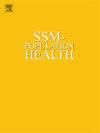Understanding the dynamics and interplay of public support and adherence to five key mitigation behaviors over the course of the evolving COVID-19 pandemic
IF 3.1
2区 医学
Q1 PUBLIC, ENVIRONMENTAL & OCCUPATIONAL HEALTH
引用次数: 0
Abstract
Behavioral measures played a critical role in mitigating the COVID-19 pandemic, and their success hinged on continued public support and adherence. This study provides novel evidence on changes in support and adherence to behavioral mitigation measures and appraises the role of pandemic fatigue to provide robust guidance for effective governance of future public health and safety crises. Data were collected from a population cohort study in the Netherlands. This study used data from six assessments (December 2020–March 2022) at 12-week intervals, aligned with differences in pandemic severity and policy stringency. The analytic sample consisted of participants (N = 20,475) randomly allocated to answer questions on support and adherence to measures, focusing on physical distancing, avoiding crowds, mask-wearing on public transport, COVID-19 testing when symptomatic, and staying home when symptomatic. Changes in adherence and support and their interplay across time were assessed using random intercept cross-lagged panel models, controlling for age, gender and education. At the end of 2020, support for mitigation measures was found to be high, with little difference between measures. Subsequent changes in support for most measures broadly paralleled changes in pandemic severity and policy stringency. Adherence was less responsive to pandemic severity and policy stringency, and was mostly stable, albeit with differences between behavioral measures. Support and adherence to COVID-19 testing steadily increased after this was recommended as of early 2021. Changes in support and adherence did not reflect the notion of pandemic fatigue as a monotonic decline in support and adherence across behaviors. Findings highlight the need to better understand and address the factors influencing differing dynamics in support and adherence to specific protective behaviors.
了解在COVID-19大流行演变过程中公众支持和遵守五种关键缓解行为的动态和相互作用
行为措施在缓解COVID-19大流行方面发挥了关键作用,其成功取决于公众的持续支持和坚持。本研究为支持和遵守行为缓解措施方面的变化提供了新的证据,并评估了大流行疲劳的作用,为有效治理未来的公共卫生和安全危机提供了强有力的指导。数据收集自荷兰的一项人口队列研究。该研究使用了6次评估(2020年12月至2022年3月)的数据,每隔12周进行一次,与大流行严重程度和政策严格程度的差异保持一致。分析样本由随机分配的参与者(N = 20475)组成,他们被要求回答有关支持和遵守措施的问题,重点是保持身体距离、避开人群、在公共交通工具上戴口罩、出现症状时进行COVID-19检测、出现症状时待在家里。在控制年龄、性别和教育程度的情况下,使用随机截距交叉滞后面板模型评估依从性和支持性的变化及其相互作用。到2020年底,对缓解措施的支持度很高,各项措施之间的差异不大。随后在支持大多数措施方面的变化大致与大流行严重程度和政策严格程度的变化相一致。依从性对大流行的严重程度和政策的严格程度反应较弱,并且基本稳定,尽管行为措施之间存在差异。自2021年初提出这一建议后,对COVID-19检测的支持和坚持度稳步上升。支持和依从性的变化并没有反映出大流行疲劳是各种行为的支持和依从性单调下降的概念。研究结果强调需要更好地理解和解决影响支持和坚持特定保护行为的不同动态的因素。
本文章由计算机程序翻译,如有差异,请以英文原文为准。
求助全文
约1分钟内获得全文
求助全文
来源期刊

Ssm-Population Health
PUBLIC, ENVIRONMENTAL & OCCUPATIONAL HEALTH-
CiteScore
6.50
自引率
2.10%
发文量
298
审稿时长
101 days
期刊介绍:
SSM - Population Health. The new online only, open access, peer reviewed journal in all areas relating Social Science research to population health. SSM - Population Health shares the same Editors-in Chief and general approach to manuscripts as its sister journal, Social Science & Medicine. The journal takes a broad approach to the field especially welcoming interdisciplinary papers from across the Social Sciences and allied areas. SSM - Population Health offers an alternative outlet for work which might not be considered, or is classed as ''out of scope'' elsewhere, and prioritizes fast peer review and publication to the benefit of authors and readers. The journal welcomes all types of paper from traditional primary research articles, replication studies, short communications, methodological studies, instrument validation, opinion pieces, literature reviews, etc. SSM - Population Health also offers the opportunity to publish special issues or sections to reflect current interest and research in topical or developing areas. The journal fully supports authors wanting to present their research in an innovative fashion though the use of multimedia formats.
 求助内容:
求助内容: 应助结果提醒方式:
应助结果提醒方式:


